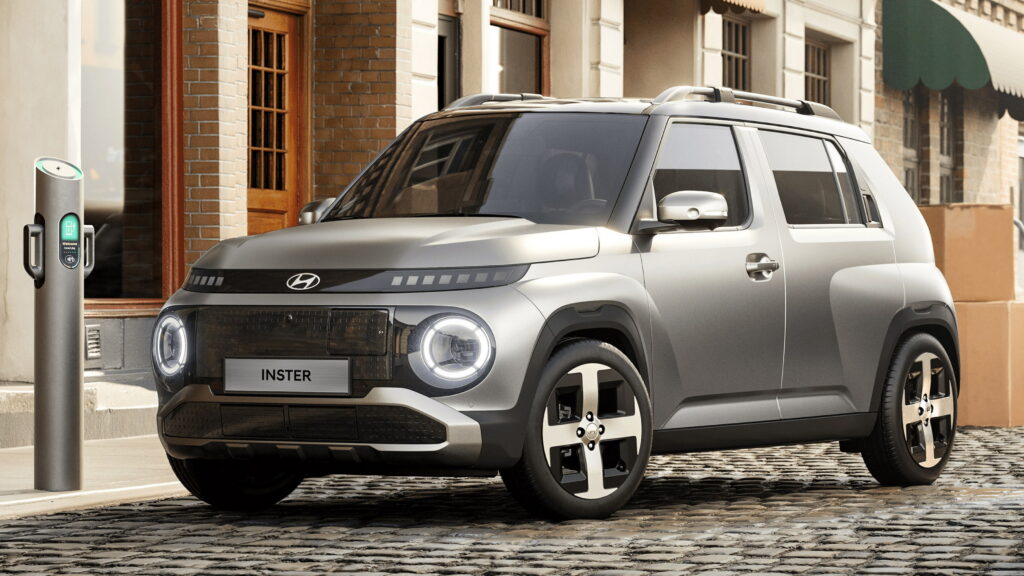- The Hyundai Inster is a new urban electric crossover based on the ICE-powered Casper.
- Its single electric motor delivers up to 113hp, offering a maximum range of 355 km (220 miles).
- Hyundai plans to launch the Inster in Korea, Europe, the Middle East, and Asia-Pacific markets.
Hyundai continues to expand its SUV lineup with the new Inster—a fully electric version of the Casper subcompact crossover, featuring a stretched wheelbase and more standard tech inside the cabin. Unlike the Casper, which is exclusively available in Korea, the Inster will also be sold in Europe, the Middle East, and Asia Pacific, making it a global model.
The Inster borrows heavily from the Casper’s 2021 design, but throws in a few electric twists to avoid accusations of pure plagiarism. Think slightly massaged bumpers, a choice of 15″ or 17″ wheels (because apparently those extra electrons demand bigger shoes), and flashier LED lights front and back. More important, however, is the Inster’s growth spurt – it’s 230mm (9 inches) longer than the Casper, with a wheelbase stretched by 180mm (7.1 inches).
Review: 2025 Hyundai Santa Fe Steps Up In All Areas
Despite the substantial stretch, the Inster maintains a pint-sized footprint. We’re talking 3,825 mm (150.6 inches) long, 1,610 mm (63.4 inches) wide, and a mere 1,575 mm (62 inches) tall, with a wheelbase of 2,580 mm (101.6 inches). Think of it as a micro-SUV with growing pains – bigger than a hamster cage, but still dwarfed by its Hyundai subcompact SUV siblings like the Bayon, Creta, Venue, and Kona.
In Europe, the Hyundai Inster will be positioned between the A-SUV (Toyota Aygo X, Suzuki Ignis) and B-SUV (Jeep Avenger, VW T-Cross) segments, making it a fitting choice for urban environments with its compact dimensions. Furthermore, Hyundai has announced an upcoming Inster Cross version, featuring a “more rugged, outdoor-focused design.”

The Hyundai Inster (above) compared to the Casper (below).

The interior design has also been largely carried over from the ICE-powered equivalent, though with technological upgrades and different color options for the cloth upholstery. The digital cockpit features dual 10.25-inch displays, significantly larger than those in the Casper.
Depending on the trim, equipment can include a wireless charging dock, 64-color LED ambient lighting, heated front seats, a sunroof, and a comprehensive suite of ADAS features for its size.
All the seats can be folded flat, with the second row sliding and reclining, and an optional front bench. The boot has a capacity of 280 liters (9.9 cubic feet), which can expand to 351 liters (12.4 cubic feet) depending on the position of the rear bench.
Two Electric Powertrain Options
The Hyundai Inster will be available with Standard, and Long Range powertrain options. The entry-level model features a single electric motor with 95 hp (71 kW / 97 PS) and and 147 Nm (108 lb-ft) of torque. Energy is sourced from a 42 kWh battery pack, allowing it to travel more than 300 km (186 miles) between charges.
For those wanting more of everything, the Long Range version is powered by a more potent 113 hp (84.5 kW / 115 PS) electric motor. This is combined with a slightly larger battery pack with a capacity of 49 kWh, targeting a segment-leading WLTP range of 355 km (221 miles). These specs are significantly better than the Korean-spec Kia Ray, the only other EV based on the Hyundai/Kia K1 platform.
Thanks to its 120 kW DC fast charging capabilities, the Inster can charge from 10-80 percent in just 30 minutes. When connected to a more commonly used 11 kW AC outlet, a full charge will take 4 hours for the Standard model or 4 hours and 35 minutes for the Long Range model. Additionally, the V2L function allows bi-directional charging for other devices like e-bikes and camping gear.
The new Inster will go on sale in Korea this summer, following its debut at the 2024 Busan International Mobility Show. A gradual rollout in Europe, the Middle East, and Asia Pacific will follow, with pricing to be announced later. Judging by its size and market positioning, this will likely be Hyundai’s most affordable EV offering.



















